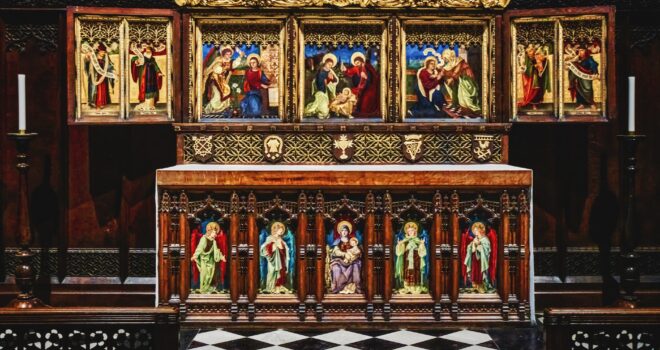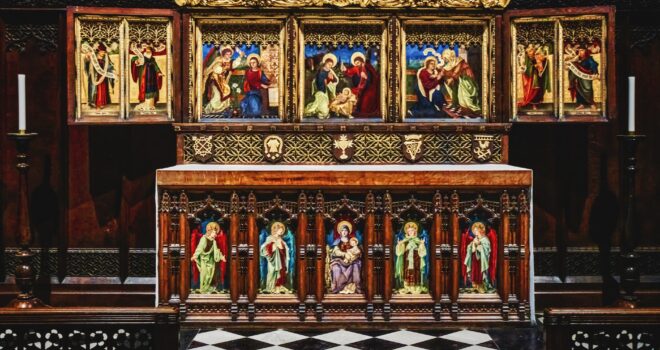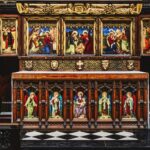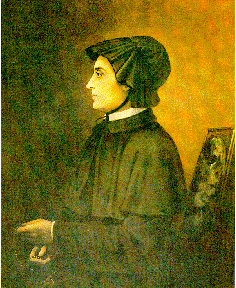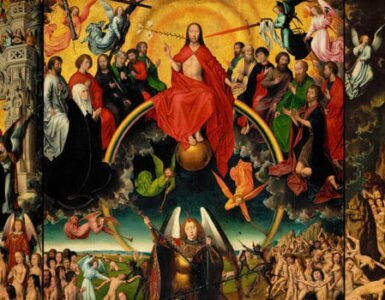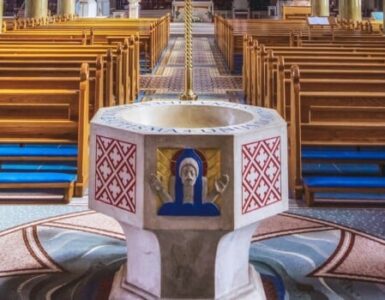Each Sunday we pray the Creed. Among the articles of Faith in which we affirm our belief is that of the communion of saints. By canonizing men and women who have lived lives of heroic virtue on earth, the Church invites us to befriend the saints, mindful that their presence in our own lives can be most efficacious. By their example and private devotions, the saints themselves teach us that there has been an uninterrupted practice of praying to heavenly men and women throughout the history of the church. Here are five saints who did so:
Saint Lucy: The accounts we have of the early martyrs only contain sparse insight into their lives. This rings true for Sts. Lucy and Agatha, both of whom were first century martyrs. Yet, one story has been passed down to us which suggests that St. Lucy had a devotion to St. Agatha. Lucy’s mother, Eutichia, suffered from a disease of the blood which doctors were unable to cure. Inspired, Lucy brought her mother on a pilgrimage to St. Agatha’s tomb, confident that there, her mother would be healed. Upon arriving at and praying before Agatha’s tomb, the saint appeared to Lucy, foretelling Eutichia’s miraculous recovery and Lucy’s martyrdom. Eutichia was immediately cured, while her daughter suffered martyrdom soon after.
Saint Thomas Aquinas: Thomas Aquinas is commonly known for his wisdom, which is likened to that of the angels. Perhaps a more obscure fact about Aquinas is his affection for the first century virgin-martyr, Saint Agnes. Not much has been recorded as to the origin of his devotion, but what we do know is most endearing, for he possessed a tender, childlike love for this saint. Aquinas carried the relics of Agnes close to his chest, and on one occasion, he cured a fellow friar, Reginald of Piperno, with her relic. In order to show his appreciation to his heavenly intercessor, Aquinas promised to host an annual dinner for his students in St. Agnes’ honor on her feast day. Thomas was only able to do so once, as he died a year later.
St. John Vianney: Pauline Jaricot, a friend of St. John Vianney, ignited the priest’s devotion to St. Philomena. Pauline obtained relics of the young martyr and upon giving them to the curé instructed: “have confidence in this great saint, she will obtain for you all that you ask.” These words soon rang true in the life of the humble curé. He restored the church of Ars and erected some small chapels, placing St. Philomena’s relics in one which he dedicated to her. St. Philomena would often appear to the curé, and biographers recorded that she would refuse the priest nothing. Throughout the priest’s life he worked countless miracles, all of which he attributed to his “dear little saint.” Pilgrims, hopeful for healing, insisted the curé bless them or a sick loved one. Instead, the humble parish priest sent them to pray before Philomena’s altar. Biographers of the Curé of Ars note that Philomena brought about a miraculous recovery in Vianney when he was deathly ill. We can experience a taste of St. John Vianney’s devotion to his dear saint by praying the Litany of St. Philomena, which he composed in his heavenly friend’s honor.
St. Gemma Galgani: Gemma Galgani, a young Italian mystic, first learned about St. Gabriel of Our Lady of Sorrows when suffering from numerous sicknesses including curvature of the spine and paralysis. She received a book on the life of St. Gabriel, and after reading it, developed a friendship with this saint. She would pray to him in times of temptation, affectionately calling him “her protector” in her diary.She wrote: “I grew in admiration of his virtues and his ways. My devotion to him increased. At night I did not sleep without having his picture under my pillow, and after that I began to see him near me. I don’t know how to explain this, but I felt his presence. At all times and in every action, Brother Gabriel came to mind.” St. Gabriel appeared to Gemma, relaying that if she wished to be cured, she should pray a novena to the Sacred Heart of Jesus. During those nine days St. Gabriel visited Gemma, and in keeping with the promise, Gemma was healed on the last day. Throughout the rest of her short life, Gemma’s affection for St. Gabriel deepened and he continued to visit her.
St. André Bessette: Saint André’s devotion to St. Joseph began in his youth, fostered by his parish priest, Fr. André Provençal. At twenty-five, André entered the novitiate at the Congregation of the Holy Cross, a teaching order, though he never taught due to health problems.Instead, André was assigned as porter of Notre Dame College in Montreal, a position in which he served for forty years. Consequently, he became acquainted with many who passed through the college’s doors. He invited those sick to pray to St.Joseph, anointing them with oil from a lamp which burned before the saint’s statue. Miraculous healings started to occur, all of which André would attribute to St. Joseph.
André desired to build a shrine in St. Joseph’s honor, a project which consumed the remaining years of his life. Although lacking the necessary funds upfront, André received permission from the bishop to build, provided he did not acquire any debt. Despite the challenges, André’s confidence in St. Joseph remained unshakeable. If St. Joseph wished for a chapel, Bessette reasoned, then St. Joseph would provide the land, the means and the funds. His faith was rewarded. Construction slowly began on the chapel, and due to the volume of pilgrims who visited, the oratory had to be expanded several times.
Today, countless crutches, braces, canes and other items left by cured pilgrims adorn the walls of the votive chapel, in gratitude to St. Joseph. Though Saint André Bessette never lived to see its completion, the Basilica of St. Joseph, the world’s largest shrine dedicated to him, stands on Mount Royal in Montreal as a powerful testament to St. André’s love for the foster father of Jesus.
Even in our own age, we can think of contemporary holy men and women who were drawn to specific saints. The late Pope Benedict XVI was greatly influenced by St. Augustine, while St. John Paul II’s spirituality was formed by St. John of the Cross. Mother Teresa’s religious name reflected her love for St. Thérèse of Lisieux, while Blessed Pier Giorgio Frassati frequently quoted St. Paul in his letters.
The lives of these holy men and women teach us that the presence of the saints enriches our lives and leads us to Christ. In fact, many blessings will occur in our lives when we become close to the saints. The example of their lives serves as a guide to Christ and inspires us in our own earthly pilgrimage. Lumen Gentium, the Second Vatican Council’s Constitution on the Church, speaks about the importance of befriending the saints: “for just as Christian communion among wayfarers brings us closer to Christ, so our companionship with the saints joins us to Christ, from Whom as from its Fountain and Head issues every grace and the very life of the people of God.” The constitution continues, declaring: “it is supremely fitting, therefore, that we love those friends and coheirs of Jesus Christ, who are also our brothers and extraordinary benefactors, that we render due thanks to God for them and ‘suppliantly invoke them and have recourse to their prayers, their power and help in obtaining benefits from God through His Son, Jesus Christ.’”
The tender love these saints had for their heavenly friends should instill in us a desire to seek the friendship of saints. Though we may never see them in this life or be inspired to build a chapel in their honor, we can develop a sense of companionship with the saints, communicate with them, receive encouragement by their example, and ask for their intercession.
Photo by K. Mitch Hodge on Unsplash


